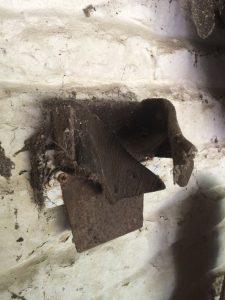There was a lot of time pressure in the last week of the internship as I tried to keep up with the project as it expanded. Originally I was going to catalogue the contents of 2 barns of agricultural equipment but ended up doing at least double that (Sacrewell has a seemingly endless supply of equipment). With the cataloguing done, I then had time to stay on and help decide what would happen to the 600+ objects I had spent hours nurturing and puzzling over. For the purpose of this task we adapted the game ‘snog, marry, avoid’ and created ‘sell, keep, scrap’. The skip arrived on the morning of my last day and thankfully next to nothing of what I had identified went in it. There was a sacred pile of objects to invest time and money into keeping and the remainder will be sold at auction. I let myself speculate about where they may end up…. In another museum, someone’s garden, redesigned into a piece of art or furniture. Hopefully they won’t end up unused in someone’s barn all over again!
The main aim was to keep things that could tell a story to our visitors.
GRANARY LADDER. The woodworms know to stay clear, as this ladder means business. It is chunky and heavy with well-worn indents from tired feet. It has lifted many pairs of legs and helped with hours of hard work lifting goods.
SPADE IRON. This thin iron plate with two worn leather straps may be covered in years of cob webs and dust, but to its previous owners it was a must have to complete the chic land worker look. The metal plate protects costly boot soles from wear after hours of stomping spades into the ground. How many ditches has it dug and how many drainage pipes has it buried?
IRON. This thin iron plate with two worn leather straps may be covered in years of cob webs and dust, but to its previous owners it was a must have to complete the chic land worker look. The metal plate protects costly boot soles from wear after hours of stomping spades into the ground. How many ditches has it dug and how many drainage pipes has it buried?
Paul Genever and his daughter Kate, farmers from Croft Farm, educated me about the important topic of land drainage. A process I was previously completely unaware of. They came for a quick look at the collection and left several hours later. We tried to visualise how the objects were used and even ended up acting as horses harnessed up and pulling one of the hay sweeps. I think this was mostly for my benefit as they knew what 99/100 items were. They kindly posted me a land drainage map of one of their fields and it is so beautiful I’m considering framing it. Previously I had no idea that all that terracotta or plastic pipe was intricately woven under every field providing the perfect water concentration for the crops. It is like the furiously flapping feet of a duck bellow a tranquil mill pond surface.
I am going to miss working outdoors, the freedom to have lunch with the peacocks, hold the rabbits or lead the donkeys on a walk. The calming sounds of the mill wheel turning and the Swallows flying overhead.
A big thank you to the team at Sacrewell and the general manger, Debbie Queen. I was made to feel very welcome and valued on the project. Thank you Imperial for sponsoring my internship and in turn helping Sacrewell move closer to preserving their collection. I hope that I can come back in 3 years’ time to the permanently set up museum collection and experience it afresh. Hopefully I will be coming back as an agricultural engineer.